New Jersey Future Blog
New Jersey’s Population Is Still Growing
March 17th, 2016 by Tim Evans
At the beginning of this year, the Census Bureau released new state population estimates for 2015. A quick analysis of the estimates reveals some interesting points.
New Jersey is still growing
Despite news stories about population growth in the Sunbelt that might have some people believing that the entire Northeast and Midwest regions are moribund, New Jersey is still growing, as it did throughout the previous decade as well (see Figure 1). It added 166,000 new residents between 2010 and 2015 — more than the population of Paterson, or of Trenton and Camden combined, or of Cherry Hill and Toms River combined. In fact, New Jersey’s numerical gain over the last five years is equivalent to more than one-fifth of the population of the entire state of North Dakota, a state that has made headlines for its Bakken oil-related rapid population growth.
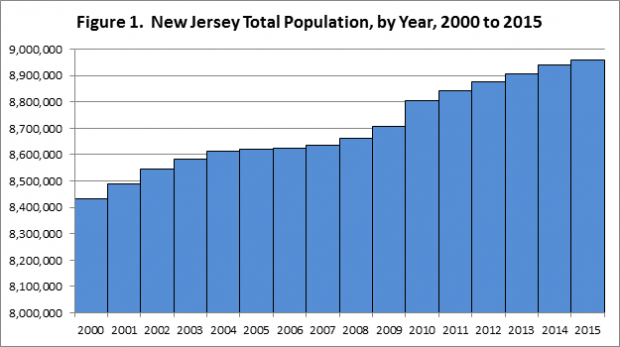 New Jersey gained a modest 19,169 new people since 2014, in contrast to seven states — Illinois, West Virginia, Connecticut, Mississippi, Maine, Vermont, and New Mexico — that actually did lose population over the last year. In fact, an additional 19 states gained fewer residents in the past year than New Jersey did, allowing New Jersey to place in the top half of states in terms of absolute increases.
New Jersey gained a modest 19,169 new people since 2014, in contrast to seven states — Illinois, West Virginia, Connecticut, Mississippi, Maine, Vermont, and New Mexico — that actually did lose population over the last year. In fact, an additional 19 states gained fewer residents in the past year than New Jersey did, allowing New Jersey to place in the top half of states in terms of absolute increases.
Population growth rate is slow
In terms of percent change, New Jersey’s growth continues to be well below that of most of the rest of the country. Its growth rate of 1.89 percent over the five years between 2010 and 2015 ranked it 35th among the 50 states. (The national population grew by 4.1 percent over the same period; New York grew by 2.2 percent, ranking 30th, and Pennsylvania grew by 0.8 percent, ranking 42nd.) In terms of growth since 2014, New Jersey ranks 36th. For comparison, it ranked 37th in percent growth from 2000 to 2010, so not much has changed.
The misperception that New Jersey is no longer growing probably arises not only from its low actual growth rate but also from stories about it losing residents to other parts of the country. And it is true that New Jersey has lost a substantial number of out-migrants to other states — from 2010 to 2015, roughly 270,000 more people moved out of New Jersey to another state than moved into New Jersey from elsewhere in the United States. This was the third largest net domestic out-migration, behind New York and Illinois and just ahead of California. Four other states have lost at least 100,000 net out-migrants since 2010: Michigan, Ohio, Pennsylvania, and Connecticut. But this is nothing new; those first six states were also the top six states for net domestic out-migration for the 2000s.
International immigration and natural increases keep New Jersey growing
How can New Jersey still be growing if it is losing so many out-migrants to other states? Because its net outflow to other parts of the United States is roughly counterbalanced by immigrants from other countries, although the cumulative totals are much closer in magnitude for the 2010-2015 period than they had been for the 2000s. From 2000 through 2009, international immigrants outnumbered net domestic out-migrants by about 48,000; for 2010 through 2015, the difference is only slightly more than 1,000. But because the difference is more often positive than negative from one year to the next, the net result is that from 2000 to 2015 more people have come to New Jersey from overseas than have left New Jersey for elsewhere in the U.S. Not all of New Jersey’s peers are lucky enough to attract international immigrants at rates sufficient to make up for their domestic losses, though; among the eight states having net domestic outflows of 100,000 or more from 2010 to 2015, only New Jersey, Pennsylvania, and California gained more international immigrants than they lost domestic migrants. In New York, Illinois, Michigan, Ohio, and Connecticut, immigrants don’t make up for net losses to other states.
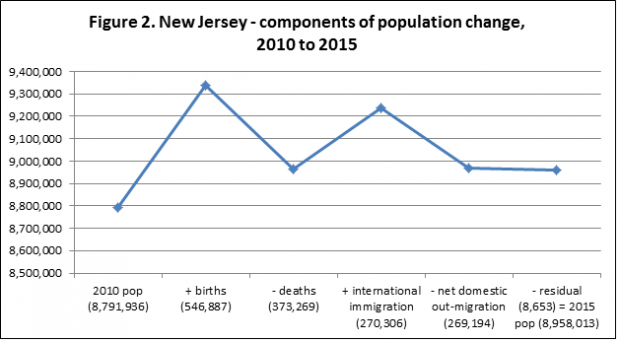 However, all eight of these states have nonetheless gained population overall since 2010, thanks to natural increase – that is, births minus deaths. West Virginia is the only state in the country that actually has fewer total residents as of 2015 than it did in 2010. Because New Jersey’s natural increase remains a net positive number (totaling 173,618 for 2010-2015) – as are all states’ except Maine’s and West Virginia’s – its total population has continued to grow, even as net domestic out-migration and international immigration roughly cancel each other out (see Figure 2).
However, all eight of these states have nonetheless gained population overall since 2010, thanks to natural increase – that is, births minus deaths. West Virginia is the only state in the country that actually has fewer total residents as of 2015 than it did in 2010. Because New Jersey’s natural increase remains a net positive number (totaling 173,618 for 2010-2015) – as are all states’ except Maine’s and West Virginia’s – its total population has continued to grow, even as net domestic out-migration and international immigration roughly cancel each other out (see Figure 2).
New Jersey losing fewer people to Pennsylvania
Another phenomenon likely resulting from changes in New Jersey’s pattern of gains and losses is visible in the state next door. Pennsylvania’s losses due to net domestic migration have grown substantially in the 2010s compared to the 2000s. For the entire 2000-2009 period, Pennsylvania lost a net 46,000 out-migrants to other states, but its net loss to other states for 2010 through 2015 is 132,000 — nearly triple last decade’s total, and for a shorter time period. If county-level population changes from earlier this decade are any indication, a likely major factor in Pennsylvania’s larger net outflow so far this decade is the evaporation of its sizable net inflows from New Jersey and New York, which had been fueled largely by the march of the New York City / North Jersey exurban growth frontier across the Delaware River into northeastern Pennsylvania. Similar to the northwestern counties of New Jersey, Pike and Monroe counties in northeastern Pennsylvania have recently done an abrupt about-face, from placing among the fastest-growing counties in the entire northeastern United States in the 1990s and 2000s to experiencing actual population losses in the early part of the 2010s. Pennsylvania’s perennial outflow to Florida and other Southeastern states is once again its main story, just like its mid-Atlantic neighbors’, now that it is no longer being partially camouflaged by an influx of Pocono exurbanites from New Jersey and New York.
The collapse of exurban flight from New Jersey into Pennsylvania is also visible in the two states’ overall population changes. Pennsylvania gained 44,000 more people than New Jersey did from 2000 to 2010, but from 2010 to 2015, New Jersey’s gain is about 66,500 larger than Pennsylvania’s. New Jersey may be losing as many out-migrants as ever to other states, but they clearly aren’t going to Pennsylvania in large numbers any more. And while Pennsylvania may still be losing people to states in the Southeast, it can no longer rely on in-migrants from New Jersey and New York to plug some of the resulting gaps.

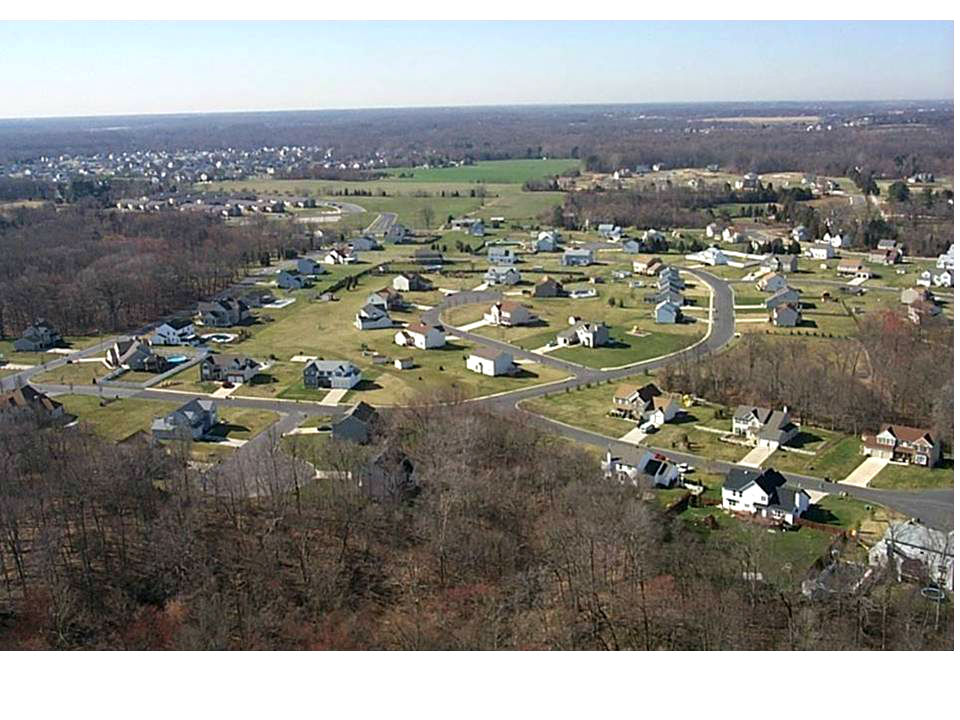
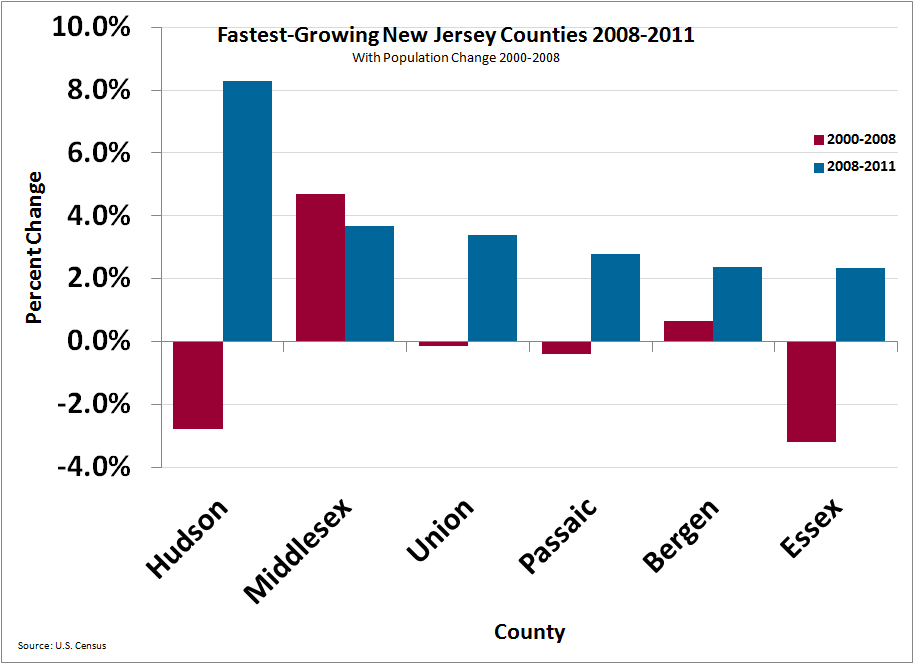
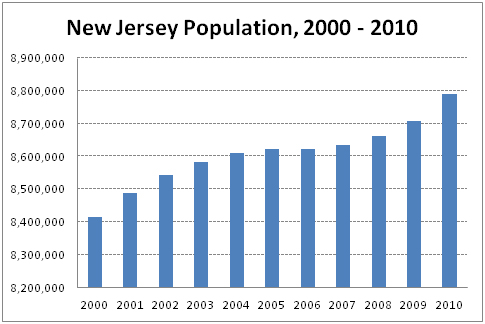
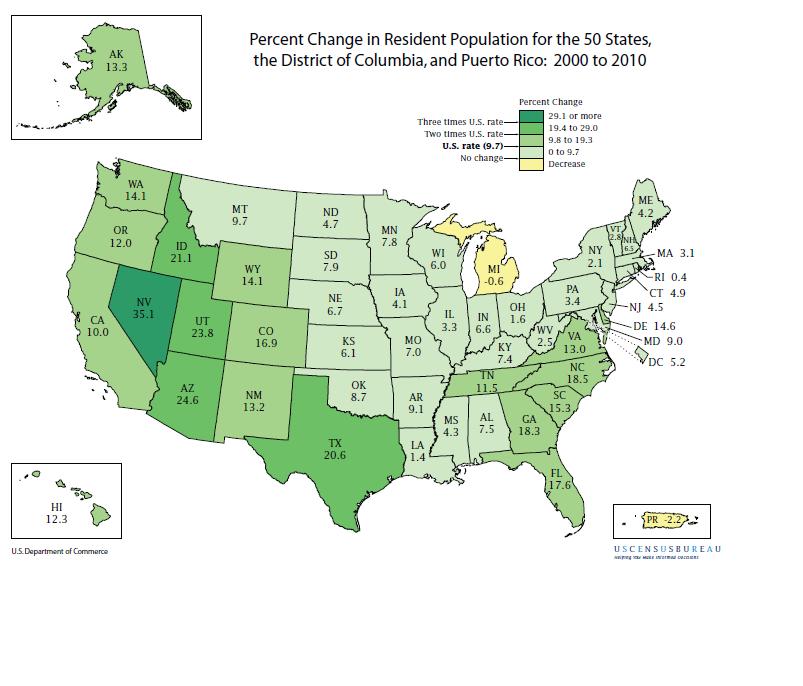












Tim – An excellent synthesis of the demographic factors at work in the state. Keep up the good work.
Brian Slaugh
An interesting analysis. However, the cited 1.89% five year growth rate ins’t correct. The total five year growth is 1.89%. The rate, which implies a annual growth, is only a fifth of that or about .38%.